Grand Prix: Seattle is just two days away, and I’m really excited to play Sealed with Dark Ascension. Most players have probably not built many Sealed decks unless they have played in their local prerelease or release events, so this format is relatively unexplored.
I judged my local prerelease at Mana Core in Providence, RI, and I was away in Hawaii for the release, so that means I have never built a Sealed deck with Dark Ascension. I didn’t want to go to GP: Seattle blind, so I decided to load up Magic Online and play in a few of the release event queues. I played in two tournaments, and I learned quite a lot. Below are the pools I received and my thought process in building the decks.
Sealed Deck #1

The first thing I did when I built from my Sealed pool is sort it by rarity. I was lucky enough to be given an Angelic Overseer and an Increasing Devotion, so white was probably the color I was going to play. My other rares and mythics were Mirror-Mad Phantasm, Cackling Counterpart, Call to the Kindred, and Fiend of the Shadows—nothing too exciting.
Next, I pulled out all of the playables in each color so I could see how deep my colors were and what I was given for creatures and removal.
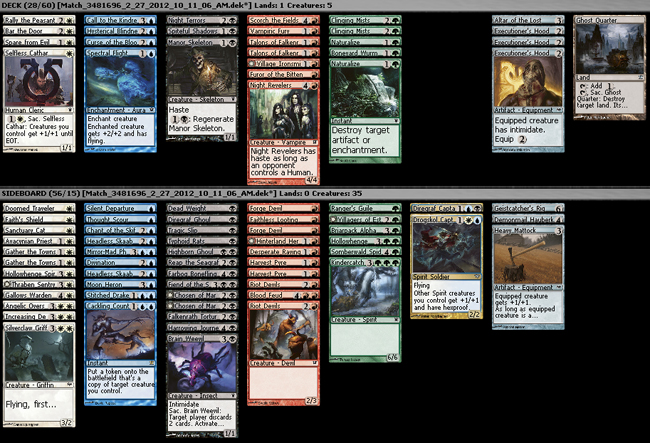
As you can see, white is my deepest color, followed by black. It’s fairly obvious that white is going to be played because of the two rares. Next, I just had to figure out what my second color would be.
When deciding what colors to play, I first looked at what removal I had. Blue gives us a Silent Departure and a Chant of the Skifsang. Neither of those cards is good, reliable removal. Silent Departure is a great tempo card, but it doesn’t permanently remove a creature. The Chant nullifies an attacker, but the creature can still block forever, and it doesn’t stop things like activated abilities.
Black gives us two excellent removal spells: Tragic Slip and Dead Weight. Red gives us two Harvest Pyres, but we can’t reliably cast them unless we have multiple ways to mill ourselves. Faithless Looting does that very well, but that’s about it. Blood Feud is another fine card, and it can usually kill two creatures, netting us card advantage. The only problem is that if one of the targets is removed, the creatures will not fight at all. Also, 6 mana is a lot, and the spell can be played around easily.
Now that we know what our removal options are, the next step is to look at our creatures and see what our mana curve looks like. Green is unplayable. There are only six cards, and the creatures are very mediocre, so there is no possible way to play our green.
The next color we can eliminate is red. Although we have a Faithless Looting and two Harvest Pyres, the creatures are all sub-par. That leaves us with two possible second colors: black and blue.
First, let’s try the W/B. We have a total of twenty-eight playables, so we need to make quite a few cuts. Here’s the deck I built:
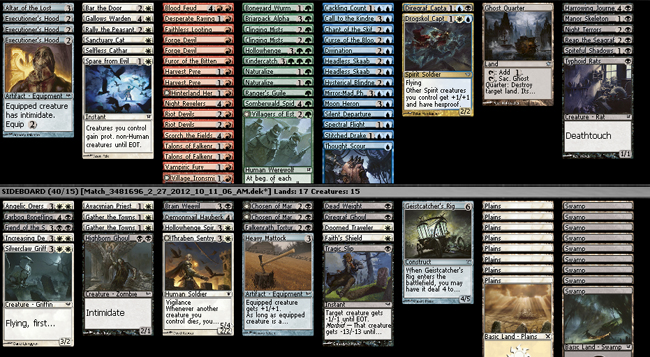
Overall, this deck looks very solid. It has fifteen good creatures and some decent removal. The only problem here is that the mana base is a little shaky. We have a Highborn Ghoul that we probably can’t play on turn two. Overall, I’m fine with playing a deck like this at a Grand Prix.
I made a few interesting choices while building this deck. First, I’m playing Demonmail Hauberk. Usually, this card is pretty bad—especially in Sealed. This deck has an unusually large number of token generators. Two Gather the Townsfolk and an Increasing Devotion make the Hauberk pretty good. We also have a lot of flyers to equip it to.
One card that I undervalued while deck-building is Falkenrath Torturer. With the number of Human tokens in this deck, the Torturer can become big very quickly. The Torturer is also a sacrifice outlet, which may be relevant if your opponent tries to steal one of your creatures or you want to remove the target of one of your opponent’s spells. The Torturer should be in this build over one of the Chosen of Markov—a very slow card that is extremely hard to transform.
This deck has a large number of 5-drops, which is something I don’t like. It’s very possible to draw a hand of no early action and just a bunch of lands and high-casting-cost spells, forcing you to mulligan. I’d still like to explore more options for this card pool.
Next, I tried a W/U deck. Here’s what I came up with:
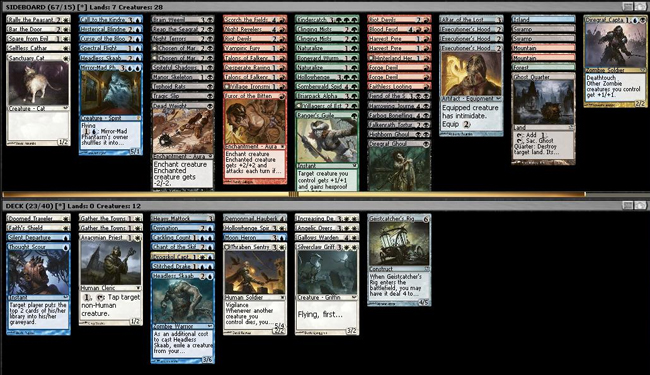
This deck looks pretty good, but it has a few major weaknesses. First, it only has twelve creatures. A low creature count isn’t really that bad, but the problem is that we have a Stitched Drake and a Headless Skaab. You need creatures in your graveyard just to cast these, and since we only have twelve creatures, we won’t be able to reliably cast these Zombies.
The next problem with this deck is the lack of removal. Chant, Silent Departure, and Avacynian Priest aren’t going to cut it. These cards can stop creatures from attacking us, but they can’t stop some of the problem cards such as Bloodline Keeper, Bloodgift Demon, and Mayor of Avabruck.
The last deck I tried was a W/U deck that splashed black for the removal spells. Here’s the deck:

Overall, this deck looks a lot better than the W/U deck. It still has only eleven creatures, but we also have some token generators, so our creature count is actually fourteen. Because of the low number of actual creatures, we can’t play the Headless Skaab. The Stitched Drake is okay and can probably be played by turn five or six. This deck also gives us some powerful cards, such as Cackling Counterpart, and a ton of flyers.
So, I had two choices of what deck to play. I could go with the W/B deck or the W/U deck with the black splash. I decided to play the W/U/b deck.
So, how did I do? I ended up going 2–2, losing to two very fast decks. One deck was a really good R/G Wolf deck with a ton of undying creatures and an Immerwolf. My draws were very slow, and I could never keep up. My second loss was to another very fast deck, a B/R deck with a lot of removal.
After this tournament, I realized that I should have played the W/B deck. The W/U/b version was way too slow and couldn’t deal with very fast draws. Also, I could never cast the Stitched Drake, which was something I feared would happen infrequently, but it happened practically every time. Another thing is that the Cackling Counterpart was really bad. I didn’t have enough creatures to make it work. One game, I was able to Cackling Counterpart my Angelic Overseer twice, and I won that one. But overall, the card was very unreliable in my deck.
Sealed Deck #2

After doing a rarity sort, you can see that we have a Curse of Death's Hold, Bloodgift Demon, and a Skirsdag High Priest. Of course, that means we want to play black if possible. Our other rares are unplayable: two Lost in the Woods and Increasing Vengeance.
After we sort out the unplayables, we are left with this:
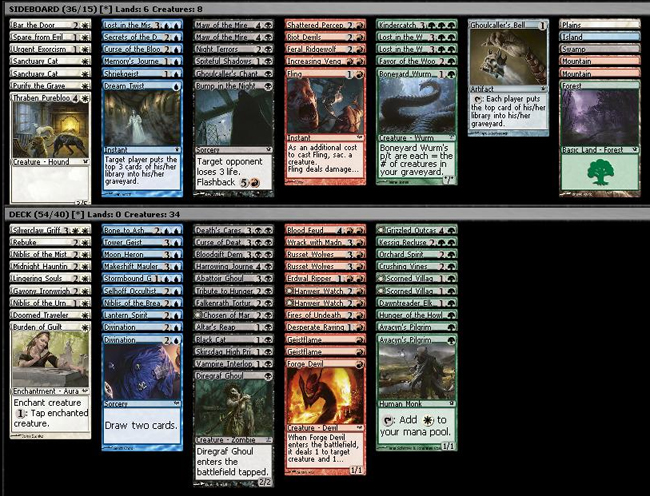
At a first glance, black is by far the deepest color. It has a lot of removal, bombs, and solid creatures. We are going to be playing black as our main color because of the three good rares we have. Our white also looks great. We have removal in the form of Rebuke and Burden of Guilt. Our creatures are very good, and we have a Lingering Souls and a Midnight Haunting, which are excellent at providing card advantage.
As for our other colors, the blue is very solid. There are a lot of flyers and ways to make card advantage. It’s definitely worth considering. Our red looks really good, too. There are a ton of removal spells. Geistflame, Fires of Undeath, Wrack with Madness, and Blood Feud are all great cards. The creatures in red are pretty decent, too. Finally, our green cards are all solid, but there is no removal, and it just isn’t on the same level as our other three colors.
My first thoughts were to try for the W/B token deck. Here’s what I came up with:
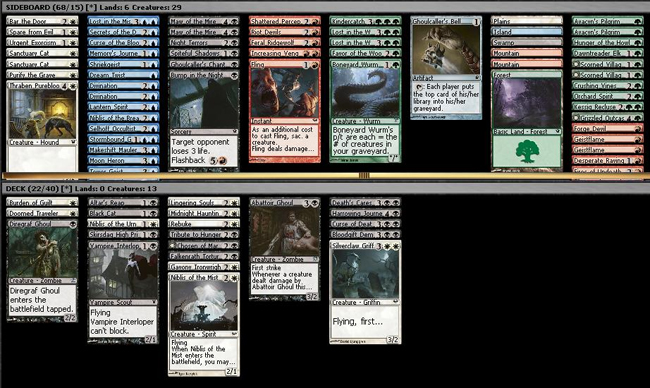
This deck has quite a few issues. First, it doesn’t have a smooth curve because it has way too many 3- and 5-drops. Next, like most W/B decks, the mana is very awkward. We need black and white mana early, making for some very bad draws and a lot of hands that we’d have to mulligan. Third, our removal is very slow. This deck uses the most powerful cards in our pool, but it’s an overall sluggish deck. As much as I want to play a deck with both Lingering Souls and Midnight Haunting, let’s try out some of our other options.
The next deck I tried was U/B:

This deck has a much better curve, but it still suffers from having too many 3-drops and not enough things to do in the early game. We do have a ton of powerful creatures, but this deck has the potential to be blown out by the fast aggro decks of the format.
The last deck I tried was B/R. Here it is:

This looks like the best deck of the three. It gives us eight removal spells, three of which have flashback. The creatures are all pretty solid, the mana base is fine, and it has a smooth mana curve. This is the type of deck that I like to have in Sealed. It’s very consistent, and it can deal with opponents with both fast and slow starts. It also has many ways to deal with bombs, which is very important in Sealed. Of course, this is the deck that I decided to go with for the tournament.
I easily 4–0’d the tournament with this B/R deck and only dropped a game in which I was badly mana flooded. This deck was great because it gave me a lot options, such as whether to use removal or play a guy, or which removal spell do use, and it allowed me to utilize my graveyard a lot. This deck had a lot of flexibility, and I’d be ecstatic to open a similar pool in Seattle this weekend.
I’m really looking forward to the Grand Prix this weekend. If you are going, I wish you the best of luck, and feel free to say “hi.” I hope these practice Sealed decks gave you some insight on the format and will help you in your future tournaments.
Follow me on Twitter at @llWeDoIsWinMTG.





















